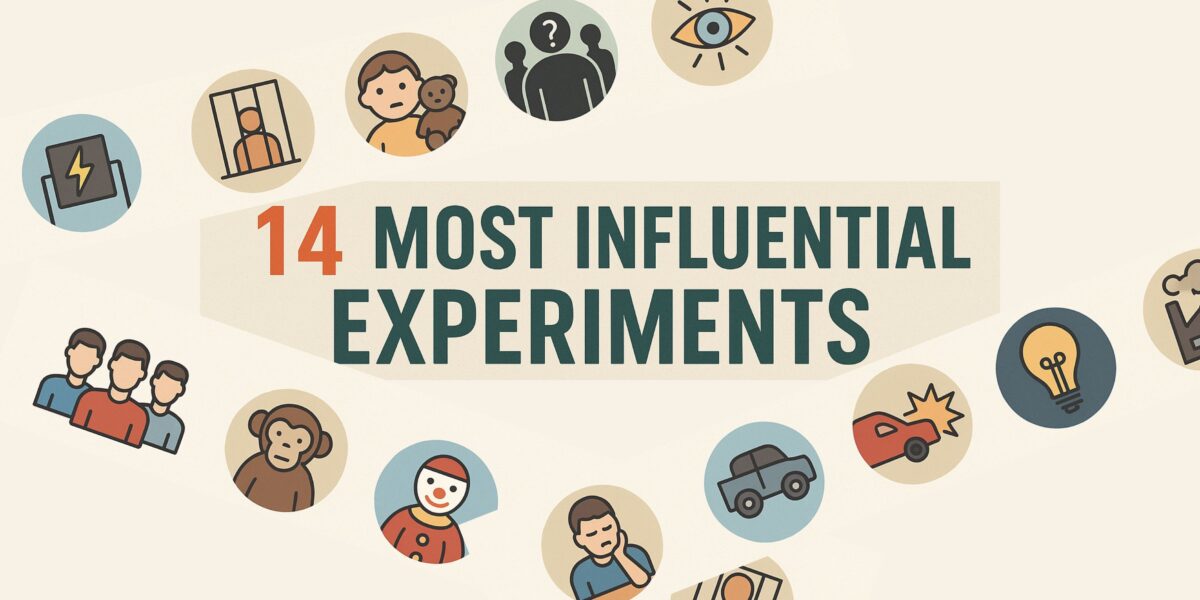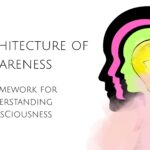Human nature and consciousness have been instrumental in the development of the world as we know now. The advancements humans have made from studying behavior have led to laws, technology and creating intelligent artificial beings from carefully crafted systems tools.
What has made all of this possible?
Experimental science.
The study of consciousness has remained one of the corner stones for the science of behavior. Throughout history, our understanding of psychology, of humans and other living beings has evolved through bold experiments that questioned long-held assumptions about human thought, behavior and emotion.
Many of these studies shocked the public. Many challenged the ethics of research itself.
However, each of these studies left an indelible mark on science.
In this series, we explore 14 of the most influential psychological experiments ever conducted. Iconic as they are, the experiments tell us how humans learn aggression, why we conform to social pressure, and how early experiences shape attachment and fear. Among many other findings.
So, let’s begin.
1. A Class Divided – Jane Elliott’s Eye-Color Lesson (1968)
In 1968, Martin Luther King Jr., a champion of race equality, was assassinated. To demonstrate just how deeply discrimination could affect education, Jane Elliott conducted a profound experiment. She was an elementary school teacher at Riceville, Iowa.
The goal was that she wanted her third graders to understand its effects – not through lectures, but by living through it.
So, she split her all-white class into two groups based on eye color. One day, blue-eyed children were told they were smarter and more deserving of privileges. The brown-eyed kids were made to feel inferior. The next day, she reversed the roles.
The transformation was immediate. One might not expect a child to become cruel or bossy, but the “superior” group did just that. However, those labeled “inferior” felt demoralized and performed worse academically.
Once the exercise ended, the children reunited and openly discussed how painful the discrimination felt.
Impact
This experiment showed through a spontaneous classroom activity how quickly prejudice can form and how deeply it affects self-esteem and behavior. Further research confirmed the significant effects of this experiment on the participants.
Elliott’s research informed modern diversity training. Much of her approach is still used in diversity training today.
2. Solomon Asch’s Conformity Experiment (1951)
Imagine you’re in a room with seven other people, and everyone says a clearly wrong answer to a simple question.
Would you stick to the truth or go along with the group?
Solomon Asch tested how much people conform in such a situation with one of his most famous experiments.
The participants were shown a line and asked which of three comparison lines matched it.
But there was a catch. All other group members were actors instructed to give the wrong answer on certain trials.
The results were surprising to say the least: about one-third of participants conformed to the group’s incorrect choice at least once. When asked privately, nearly everyone answered correctly.
Impact
Asch’s findings highlighted how powerful social pressure can be. It could even lead people to conform despite knowing that the answer they are being pressured to give isn’t the right one. All of that is possible without the possibility of being punished or reprimanded.
This has implications for decision-making, peer influence, and group dynamics.
The findings of Asch’s experiments opened up psychological research on social conformity. For example, Milgram’s obedience studies stemmed from Asch’s work (Milgram was Asch’s doctoral student), extending the analysis of group pressure to obedience to authority figures.
Furthermore, theories on minority influence, groupthink, and the bystander effect often reference Asch’s basic framework as a jumping‑off point for group behavior analysis
3. Albert Bandura’s Bobo Doll Experiment (1961–1963)
Violence begets violence.
Matthew 26:52
Why is it the case that children who grow up in violent environments are more comfortable with using violence as a means?
In the early 1960s, Albert Bandura explored whether children learn aggressive behavior simply by watching adults.
This study did not attempt to explore beliefs. It only focused on the behavior of these children after they observed violence and aggression.
Basically, the children were divided into groups: some watched an adult aggressively hit and yell at an inflatable “Bobo doll,” others saw a calm adult, and a control group saw no model.
Later, when given the same doll, children who saw aggression were far more likely to mimic those violent actions and words. The children’s actions also differed based on their gender. Boys showed more physical aggression than girls, particularly when observing a male model.
Impact
This study demonstrated that observational learning plays a key role in the development of behavior. One does not need to do violence to learn it. The experiment shifted psychology from focusing solely on rewards and punishments to recognizing that we imitate what we see—a principle still relevant to understanding media influence on children.
This prompted public concern and legislative action on media violence in the 1970s and beyond. U.S. congressional hearings cited Bandura’s work when considering TV and video game content ratings.
While the assertion that video games directly cause violence is not based on science, video games can play a significant role in increasing aggressive behavior and emotions.
Bandura’s experiment also led to a shift in teaching practices and academia. Social Learning Theory, born from the Bobo Doll findings, is central to modern teaching and parenting. After all, role modeling, peer observation, and reinforcement are foundational tools in shaping behavior.
We have much to thank for when it comes Albert Bandura’s work!
4. Little Albert – Conditioning Fear (1920)
John B. Watson has been considered to be the founder of the behaviorist school of psychology. His work focused mainly on the mechanisms of learning.
“Give me a dozen healthy infants, well-formed, and my own specified world to bring them up in and I’ll guarantee to take any one at random and train him to become any type of specialist I might select.”
John B. Watson
However, instead of how children learn violence, Watson and Rosalie Rayner devised one of the most famous psychological experiments to see how children learn fear.
They introduced a 9-month-old baby, “Albert,” to a white rat.
Initially, Albert was unafraid. But when Watson struck a loud steel bar every time Albert touched the rat, the child began to cry. With time, Albert started exhibiting signs of fear in the presence of the rat even when the steel bar wasn’t struck.
Thus, the shock and fear associated with the loud sound experienced by the baby was generalized to another stimulus in the environment, the rat.
This process is called generalization, a key principle of behaviorist psychology.
Soon, Albert showed fear not only toward the rat but also toward similar objects like rabbits, dogs. He was fearful of even a Santa beard.
Impact
The experiment was controversial, but it revealed that emotional responses can be classically conditioned in humans. Previously, it had only been studied in Pavlov’s experiment, with the dogs salivating to a bell.
Aside from this, the findings were foundational to later therapies such as systematic desensitization, exposure therapy, behavior modification, and elements of CBT. These approaches are widely used to treat phobias and anxiety disorders today.
The Little Albert experiment however gained notoriety as well. The Belmont Report of 1979 made sure that research like this and the Tuskegee Syphilis Study could not be ethically permitted. On the side of academic criticism, Ben Harris’s (1979) critique summed up problems with reporting, the lack of control trials and ethics.
Nevertheless, therapies incorporating psychological techniques that were outlined by Watson – such as exposure response prevention – do continue to benefit millions around the world who suffer from phobias.
5. The Stanford Prison Experiment – Power and Authority (1971)
The dynamics of power has been an interesting field of psychological investigation. From Plato, Nietzsche and Machiavelli to Foucault and Lacan, the question of how power arises as a part of human psychology has seen many answers.
But what would happen if regular people (who have not experienced political or much social power) are suddenly given immense control over others?
Psychologist Philip Zimbardo wanted to investigate how ordinary people behave when given power. He also studied the other side of the coin, observing the behavior of people placed under the authoritarian control of the former.
He set up a simulated prison in Stanford University’s basement and randomly assigned student volunteers to be “guards” or “prisoners.” Within days, the guards became abusive, humiliating prisoners and enforcing certain rules out of personal satisfaction. Much like the concept of sadism.
Soon, the prisoners became submissive or emotionally distressed. The situation deteriorated so rapidly that the two-week study was cut short after just six days.
Impact
The experiment demonstrated how situational forces, isolation of stimuli and deindividuation along with enforced roles can alter behavior. It showed how individuals bypassed personal morals due to the allure of power. As such, the experiment became a cornerstone for understanding deindividuation, obedience, institutional behavior, and the darker side of human nature.
A subject interesting for moral psychology.
In fact, Zimbardo’s testimony before Congress referenced the study when discussing prison reform and juvenile incarceration. As noted by the Stanford Report, the study’s footage and analysis have been used in law enforcement, military training, and criminal justice education to illustrate how unchecked authority and role expectations can lead to abuse.
Understandably so, much like the Little Albert experiment, the Stanford prison study also raised enduring debates about ethics in research. Some critics argue that informed consent was not taken prior to the experiment. So, the participants had no knowledge about the potentially devious effects of this study.
These issues were addressed generally in the Belmont Report.
6. Milgram’s Obedience Study – Following Orders (1961)
Stanley Milgram, intrigued by the question of how ordinary people could commit atrocities during wartime, conducted a study on obedience. This study was also, much like Zimbardo’s prison experiment, conducted to see how individuals would react to encouragement of questionable acts in a controlled, borderline-authoritarian environment.
Participants were instructed to administer electric shocks to a “learner” (an actor) for wrong answers. As the shocks intensified, many participants expressed discomfort.
But when urged by the authority figure running the experiment, 65% continued to the maximum voltage, understanding that they were causing serious harm.
Impact
Milgram’s work revealed the extraordinary power of authority in driving people to act against their conscience. This discovery has troubling ramifications for both the subjects for people in general. No one, not even Milgram himself, expected such a high percentage of compliance.
It fundamentally changed how psychologists understand compliance and is often cited in discussions of military, corporate, and political obedience.
There are a few lessons to be learned, as noted by Thomas Blass in his book, The Man Who Shocked the World: The Life and Legacy of Stanley Milgram.
First, the experiment demonstrated the strength of the tendency of people to obey. The presence of this tendency was acknowledged in a high obedience rate. A further nuanced, intrusive data collection might have yielded broader results. There were methodological lackings in the study.
Nevertheless, Milgram’s experiment demonstrated how people’s inclination to comply might lead them to behave against their moral convictions. Those kinds of violent acts do not require bad people to commit them.
Second, the experiment demonstrated the internal alterations that acted as mediating factors to enable harmful compliance.
Due to the debriefing of the rules and a controlled environment, possibly individuals were more inclined to obey a disembodied voice’s harsh commands than they otherwise would have been. As such, a change in internal states, including physiological reactions, can greatly alter behavior. This shows that legitimacy of authority is in a psychological context. Certain characteristics can make authority seem absolute; certain stimuli including a reasonable control of autonomy, atmosphere, tone of voice giving prompts, colors.
The experiment provides circumstances where authority is highly suggested but not completely debriefed.
The controversy surrounding the experiment helped in bringing the importance of informed consent to the forefront of research. The World Medical Association produced the Declaration of Helsinki to advise medical researchers in protecting human patients’ well-being. The initial presentation took place during the General Assembly in 1964. The Declaration of Helsinki, unlike its precursor the Nuremberg Code, demands informed permission from study subjects.
Debriefing is a necessary part of psychological research to ensure the least amount of psychological distress.
7. Harry Harlow’s Monkey Experiments – The Need for Comfort (1958)
At the time, it was believed that infants bonded with their mothers mainly for food and affection. Harry Harlow demonstrated how comfort affected the bonding of a child with his experiments on rhesus monkeys.
He gave infant monkeys two surrogate “mothers”: one made of wire that dispensed milk and another covered in soft cloth that offered no food. The monkeys did consume the milk. However, despite food coming from the wire figure, the monkeys overwhelmingly clung to the cloth mother for comfort, especially when frightened.
In another experiment, Harlow noted that monkeys who lived with surrogate mothers for x amount of time exhibited significantly different behaviors from another monkey living with surrogate mothers for y amount of time. The main finding of the experiment was that social behavior could be altered depending on comfort associated with bonding.
Impact
In particular, Harlow showed that emotional security and warmth are essential for healthy attachment, not just physical sustenance. This research reshaped child-rearing advice and influenced theories of emotional development and attachment.
Harry Harlow’s research provided much required experimental and empirical evidence to psychoanalytic theory – especially with regards to object relations and attachment.
8. Loftus and Palmer’s Memory Distortion Study (1974)
Our memories feel like video recordings of past events, but they can be surprisingly unreliable. Psychologists Elizabeth Loftus and John Palmer demonstrated the unreliability of memory in their groundbreaking study on eyewitness testimony.
Participants watched a film of a car accident and were later asked questions about what they saw. The twist was in the wording: one group was asked how fast the cars were going when they “hit,” another when they “smashed” into each other. The difference in wording led to dramatically different speed estimates, with the “smashed” group recalling much higher speeds.
When asked later if they saw broken glass (which was never shown), participants in the “smashed” group were far more likely to say yes.
This shows how usage of certain leading words or prompts could elicit memory responses which share the bias in the question itself.
Impact
This study revealed that memory is reconstructive—it can be altered by post-event information or cues. It revolutionized legal practices by showing that eyewitness testimony is not always reliable.
Some improvements in the legal system have been directly influenced by this research. For instance, the New Jersey Supreme Court recommended that jurors be informed that eyewitness evidence isn’t always trustworthy, back in 2012, referring to the study. Moreover, the study also influenced police interview methods and courtroom procedures worldwide.
9. Festinger and Carlsmith’s Cognitive Dissonance Experiment (1957)
We like to think we’re rational beings, but sometimes we change our beliefs just to align with our actions. This phenomenon, called cognitive dissonance, was famously demonstrated by Leon Festinger and James Carlsmith.
Participants were asked to perform boring tasks (turning pegs for an hour), then offered either $1 or $20 to tell another person the activity was fun. Surprisingly, those paid only $1 later reported actually enjoying the task more than those paid $20.
Given that they were paid more, it would seem reasonable at first that those who received $20 would claim to have liked it more.
The trick, though, is this:
The $20 group had ample reason to lie: “It’s okay if I say it was fun because I got paid a lot.” Their action was justified by the large payoff; therefore, they didn’t need to adjust their ideas. In fact, they still found the work dull – much like the control group which wasn’t asked to recommend the activity to anyone. So, as such, they did not claim to like the activity with much vigor.
On the other hand, the $1 group did not have the same incentive (“I lied for just $1?”). Cognitive dissonance was the result of the smaller reward. This is reflected in the results as they showed greater enthusiasm while recommending the activity.
All in all, compared to the large reward group and the control group, the small reward group’s real attitude changed more.
Why? Receiving a small reward didn’t justify lying, so participants reduced the discomfort (dissonance) by trying to convince others that the activity they did was actually interesting – when it really wasn’t.
Impact
This classic experiment showed how we adjust our attitudes to match our circumstances. Festinger’s experiment helped shape theories in persuasion, self-justification, and marketing psychology.
Contrary to behaviorist expectations (that greater rewards strengthen attitudes), this study showed that smaller rewards often produced stronger internal change—since people needed to justify their behavior internally when external justification was weak. This shifted social psychology to more cognitive explanations.
Not only that, but cognitive dissonance theory has also influenced the field of advertising. It is a mainstay theory of consumer behavior which has stood the test of time.
10. The Hawthorne Effect (1920s–1950s)
The Hawthorne Effect is a psychological phenomenon entailing that when people know they’re being observed, they change their behavior. The experiments that led to this discovery were not conducted by the discoverer of the phenomenon, Henry Landsberger.
Rather, back in the 1920’s and 1930’s, the Hawthorne studies were conducted in a factory just outside Chicago. The original researchers wanted to know if better lighting would boost worker productivity.
It did—but strangely, productivity also rose when lighting was dimmed.
Decades later, Henry Landsberger analyzed these results and coined the term Hawthorne Effect.
Impact
The Hawthorne Effect reminds psychologists and researchers to account for observation bias when designing studies. It’s also influenced workplace management, education, and medical research.
Before the Hawthorne studies, management theories emphasized financial incentives and efficient processes (think Taylorism and scientific management). The Hawthorne findings fundamentally reframed this view, highlighting that social and psychological factors—like feeling noticed or part of a team—play a powerful role in productivity. This shift birthed the Human Relations Movement, which focuses on group dynamics, interpersonal relationships, and emotional well-being at work
Moreover, practical steps like regular performance reviews, employee surveys, decision-making involvement, and fostering supportive workplace environments stem directly from the idea that employees perform better when they feel valued and closely observed.
11. The Kitty Genovese Case and the Bystander Effect (1964)
In a tragic real-world event, Kitty Genovese was murdered outside her apartment in New York while reportedly dozens of neighbors reportedly heard her cries for help. Few intervened or called the police.
This led psychologists John Darley and Bibb Latané to study what they called the bystander effect. In lab experiments with college student recruits and simulating emergencies – in this case, a confederate having a seizure during a discussion over an intercom (the basic setup of the experiment), they found that the more people present, the less likely anyone is to help; each person assumes someone else will act.
To break it down, when only one individual thought that they were listening to the cries of help (by the confederate), 85% of the people came to help. When they thought there were 2 or 3 others who listened as well, 62% of people attempted to aid.
However, knowing that 5 or more people were also listening to the cries of help, only 31% of the people helped.
This was explained through the fact that with more people present, the responsibility of corrective action diffuses. Which was why it took more than an hour after Genovese’s encounter with her murderer for help to actually arrive.
Impact
This insight changed emergency response training. CPR courses, for example, now teach rescuers to point directly to someone and say, “You call 911,” reducing diffusion of responsibility.
The creation of the 911 emergency system in the United States was one of the most significant and practical actions in response to the identification of the bystander effect. Policymakers saw the necessity for a centralized, single-point reporting system that removes diffusion of responsibility after being partially prompted by the reporting of the Kitty Genovese case.
The decision-making process was explained by Darley and Latané’s introduction of the Five-Step Model of bystander intervention, which consists of noticing, interpreting, admitting responsibility, choosing to help, and acting. Currently, this approach is essential to psychological research and intervention strategy creation.
12. Seligman’s Learned Helplessness Experiment (1967)
While studying classical conditioning in dogs, Martin Seligman made an unexpected discovery. Dogs exposed to unavoidable shocks eventually stopped trying to escape—even when later given the chance to avoid them.
The animals had learned that their actions were useless, leading to helpless behavior. Seligman later connected this to human depression: when people repeatedly face failure or uncontrollable stress, they may stop trying altogether, even when opportunities to improve arise.
Impact
Learned helplessness influenced therapies for depression and anxiety, shifting focus toward empowering individuals to regain control of their lives.
The model was improved by Abramson, Seligman, and Teasdale (1978) by adding attributional style, which states that people’s explanations of failure (internal, stable, or global) influence how long they feel hopeless and depressed.
Moreover, in context of psychotherapeutic practice, redefining setbacks through cognitive reconfiguration as transient, particular, and external has shown to have efficacy. This is particularly true of factors which people think are uncontrollable.
Moreover, learned helplessness gave birth to the concept of learned optimism, which is a positive psychology notion that fosters resilience. Currently, learned optimism has widespread applications, particularly with regards to health, social life and career prowess.
13. Rosenhan’s “Being Sane in Insane Places” (1973)
What if psychiatric diagnoses are influenced by context rather than clear symptoms? Psychologist David Rosenhan tested this by sending healthy “pseudo-patients” into psychiatric hospitals. They claimed only one symptom—hearing a voice saying “empty, hollow, thud”—but otherwise acted normally.
All were admitted with diagnoses of schizophrenia. Once inside, they behaved normally, yet the staff failed to recognize they were sane. Some were hospitalized for weeks.
In a follow-up, Rosenhan told hospitals he’d send pseudo-patients (but didn’t); many real patients were wrongly suspected of being impostors.
Impact
This study exposed flaws in psychiatric diagnosis and treatment. It prompted reforms in mental health care and fueled debate over labeling and stigma in psychiatry. Once tagged, every behavior was filtered via the diagnosis, illustrating how clinical interpretation is highly biased by situational context.
Along with Robert Spitzer’s concerns, this study had a significant impact on DSM revision. DSM-III (1980) provided significantly more precise definitions of mental diseases, as well as specific recommendations for who should be included or excluded from each categorization. For example, in DSM-III, a hallucination had to be repeated multiple times; in DSM-IV (1994), hearing voices had to be experienced for more than a month before a diagnosis of schizophrenia could be established; and in DSM-5, this is extended to six months.
14. Ekman’s Universal Facial Expressions Study (1971)
Are emotions shaped by culture, or are they biologically universal? Psychologist Paul Ekman conducted a cross-cultural study on identification of 6 basic emotions: happiness, anger, sadness, fear, surprise, and disgust.
He started by testing members of ‘literate’ civilizations, including those in the United States. He later visited a remote group—the Fore tribe in Papua New Guinea—who were not exposed to Western media in order to rule out cultural learning.
A picture of a facial expression was displayed to the participants. They were asked to select the picture that best suited brief, heartfelt narratives (such as “His child has died” or “He is about to fight”).
For participants in the U.S., Japan, Brazil, Chile and Argentina, an accuracy of 70-90% was observed. While conducting the experiment on the Fore tribe, Ekman noticed similar results. For happiness, recognition was well over 80%, while for anger, contempt, and sadness, it was between 70 and 80%. Although they were occasionally puzzled, fear and surprise were nonetheless identified at levels much above chance.
There was a second part to the study too, in which the researchers photographed the tribe members and asked Western participants to identify their emotions. The Western participants accurately identified the emotions accurately, usually more than 64% of the time. However, when it came to distinguishing surprise and fear – the accuracy dropped.
The study showed that even in isolated cultures with no exposure to Western media, people accurately recognized these emotions, and vice versa.
Impact
Ekman’s work demonstrated that core human emotions could be biologically hardwired, transcending culture. This finding has influenced everything from cross-cultural communication to modern lie detection techniques.
Ekman and Wallace Friesen developed the facial action coding system (FACS), an anatomically based system that decomposes facial expressions into specific muscle movements known as Action Units. FACS is still the gold standard for objectively coding and analyzing facial behavior, and it is widely used in psychology, animation, gaming, AI, and other fields.
Ekman’s discovery of microexpressions – brief, involuntary facial expressions – became a cornerstone in deception detection. He co-led the Wizards Project, which sought to uncover unusual individuals capable of detecting deceit with amazing precision. His approaches have influenced training for law enforcement, the TSA, and intelligence officials.
Wrapping Up the Series
While the list of experiments that have influenced modern thought and science is a much larger one, these 14 experiments form the backbone of modern psychology. In sum, they’ve shown that:
- Memory can be manipulated.
- Our beliefs adapt to match our actions.
- Observation alone can change behavior.
- Social dynamics often override individual responsibility.
- Repeated failure can lead to hopelessness.
- Mental illness diagnoses can be flawed.
- Emotions are universal and biologically ingrained.
Together, these groundbreaking experiments transformed therapy, legal systems, mental health care, education, and our understanding of human nature. They remind us that psychology is not static. Rather, human thought and behavior has potential for evolution and biases.
As psychologists continue to test traditional assumptions and shed new light on the mysteries of the mind, one can hope for many more discoveries to come!
I am a Clinical Psychologist and a Lecturer of Psychology at Government College, Renala Khurd. Currently, I teach undergraduate students in the morning and practice psychotherapy later in the day. On the side, I conjointly run Psychologus and write regularly on topics related to psychology, business and philosophy. I enjoy practicing and provide consultation for mental disorders, organizational problems, social issues and marketing strategies.





